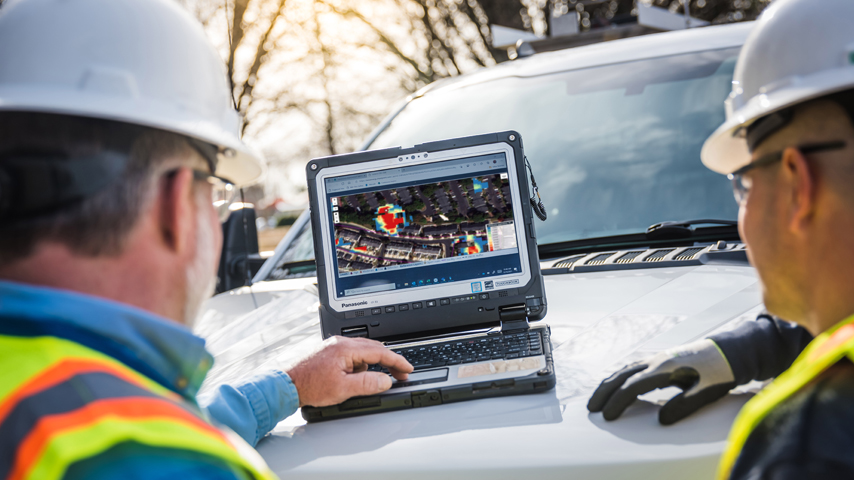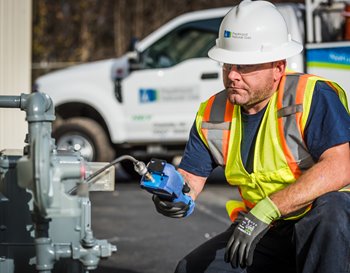AI-Assisted Methane Monitoring, Timely and Proactive
AI-Assisted Methane Monitoring, Timely and Proactive


Greening the oil and gas industry requires regulators work with utilities, suppliers, customers, and vendors to define best practices, accurately measure performance, and reduce methane emissions.
The U.S. Secretary of Energy declared a war on methane, calling the gas “more destructive than carbon dioxide to our health and environment.” The Department of Energy (DOE) clarified that the country’s natural gas pipelines, compressor stations, and other infrastructure emit about 8 million tonnes of methane annually, the equivalent of 200 million tonnes of carbon dioxide.
Often seen as unavoidable, methane leaks are part of the natural gas industry. Utilities release gas routinely and intentionally—to lower pressure or empty pipelines for maintenance, for example. But a vast network of connecting pipelines and infrastructure is made up of inefficient compressor stations, pipelines plagued with loose flanges gaskets, leaky screwed connections, worn valve-stem packing, and generally outdated equipment.
Using a mixture of ground-based tools such as “walking the line,” aerial drone surveillance, and satellite monitoring, reducing methane emissions is daunting, costly, and unrelenting.
The ultimate goal of $32 million in DOE funding is infrastructure that is not only efficient and resilient, but “leak-tight.” By providing money to companies to help them meet the current administration’s goal, the DOE aims to cut global methane emissions by 30 percent from 2020 levels by 2030.
DOE’s Office of Fossil Energy and Carbon Management awarded Duke Energy, Charlotte, N.C., $1 million in funding to further its Integrated Methane Monitoring Extension project. Reportedly, the energy provider has already reduced recordable methane leaks by more than 85 percent using satellites, sensors, and other technologies to find leaks, measure them, prioritize risk, and then take action to mitigate the problem.
Duke hopes to use the funding to evaluate emerging methane-monitoring technologies as an addition to, not a replacement of, its aerial and satellite monitoring as well as its surface-based technologies such as hand-held measurement devices and vehicle-based detection sensors, explained Lauren Crowe, director of business transformation & continuous improvement for Duke’s Natural Gas Business Unit.
Crowe emphasized Duke’s alignment with PHMSA regulations and its commitment to “go above and beyond.” Duke began with its Greenville, S.C. jurisdiction, and is sold on satellite monitoring that has proven to be a great tool for mass detection across miles of pipe and millions of customers. “So it's taking us from a space of needing three years to walk a jurisdiction to a satellite having the data delivered in a matter of days,” she explained.
For its risk-based modeling, Duke will continue working with its Microsoft Azure-based platform on real-time data collection to better inform Duke Energy’s field response team. Cloud-hosted, the platform takes in a high-volume of data from a variety of sources and types, from satellites, fixed-wing aircraft, and ground-level sensing technology.
Crowe likened the work with this amount of data to “drinking from a fire hose.”
“So our hope is we have a risk-based prioritization model that we respond to everything that's seen and we mitigate it. And by the time that we task another satellite capture, or we have another flight, or we deploy another continuous monitoring device that we've mitigated everything. And we're able to prove it with that next data collection period. And that's just much different than what we do today,” she said.
Become a Member: How to Join ASME
The emphasis on analytics amplifies the need for artificial intelligence. “I'd say AI is at the core of everything our platform is and will do,” Crowe said. “We use AI to essentially process short, infrared data.” Duke also has historical data. So the system can assess, for example, if the leak is new or one that they have seen in the same location in the past. The size of the leak is another factor. As well if what the leak happens to be adjacent to, fpr example, a public building. Risk factors can change for many reasons.
Right now our current satellite advanced methane detection provider, Satelytics, uses imagery from a short-wave infrared sensor capable of methane detection at a resolution that has made it possible to detect small leaks on assets such as meter sets. Other satellites are able to detect methane, but do not offer the resolution necessary. “We could be talking about a leak on a fitting on a meter set,” Crowe said.
“We’ve seen leaks with the satellite that we've confirmed that are less than 100 parts per 1 million in size,” she explained. “And some of these continuous monitoring or handheld devices that we're planning to supplement alongside the satellite—when we're doing ground truthing—some of them even go down to parts per 1 billion.”
More for You: Energy Blog: Reducing Methane Emissions
The ability to gather more informed data more frequently better informs Duke’s processes. “We aim to have the near real-time insights to ask ourselves, ‘should we repair a section of pipe with 15 leaks or simply replace an entire component or section of pipe?’” Crowe offered as an explanation of more sensitive and timely data.
Another is getting ahead of problems that make themselves known early in the process through trending. “The platform has helped us identify a problem with new meter sets and how we're designing that prefab assembly,” she explained. Better information allowed Duke to stop installing assemblies that have the tendency to eventually leak, for example.
It will also allow Duke to better assess its program with real data. “Does it make sense to spend our dollars on walking the line when we found a proven method that is just as good, if not better, at detection?” she asked.
That is the vision, but Duke is not there yet. The utility knows it must include regulators and prove to them that their new system works and can be relied upon to monitor, measure, and mitigate methane leaks. It aims to continue to partner with other utilities, technology vendors, and regulators to build the business case for adoption of advanced leak detection technologies and methods.
“Our platform exists. We see this funding as a way to mature it,” Crowe explained. Duke will use the funding to test emerging technologies, but ultimately the money will be used to further develop the data model and “to mature the AI to build a standard admissions, accounting, and reporting framework that could be useful across the entire value chain.”
Duke is moving toward net zero with “a really good, solid foundation in place,” Crowe concluded.
Cathy Cecere is membership content program manager.
Often seen as unavoidable, methane leaks are part of the natural gas industry. Utilities release gas routinely and intentionally—to lower pressure or empty pipelines for maintenance, for example. But a vast network of connecting pipelines and infrastructure is made up of inefficient compressor stations, pipelines plagued with loose flanges gaskets, leaky screwed connections, worn valve-stem packing, and generally outdated equipment.
Using a mixture of ground-based tools such as “walking the line,” aerial drone surveillance, and satellite monitoring, reducing methane emissions is daunting, costly, and unrelenting.
Duke Energy project
The ultimate goal of $32 million in DOE funding is infrastructure that is not only efficient and resilient, but “leak-tight.” By providing money to companies to help them meet the current administration’s goal, the DOE aims to cut global methane emissions by 30 percent from 2020 levels by 2030.
DOE’s Office of Fossil Energy and Carbon Management awarded Duke Energy, Charlotte, N.C., $1 million in funding to further its Integrated Methane Monitoring Extension project. Reportedly, the energy provider has already reduced recordable methane leaks by more than 85 percent using satellites, sensors, and other technologies to find leaks, measure them, prioritize risk, and then take action to mitigate the problem.
Duke hopes to use the funding to evaluate emerging methane-monitoring technologies as an addition to, not a replacement of, its aerial and satellite monitoring as well as its surface-based technologies such as hand-held measurement devices and vehicle-based detection sensors, explained Lauren Crowe, director of business transformation & continuous improvement for Duke’s Natural Gas Business Unit.
Crowe emphasized Duke’s alignment with PHMSA regulations and its commitment to “go above and beyond.” Duke began with its Greenville, S.C. jurisdiction, and is sold on satellite monitoring that has proven to be a great tool for mass detection across miles of pipe and millions of customers. “So it's taking us from a space of needing three years to walk a jurisdiction to a satellite having the data delivered in a matter of days,” she explained.
Data analytics
For its risk-based modeling, Duke will continue working with its Microsoft Azure-based platform on real-time data collection to better inform Duke Energy’s field response team. Cloud-hosted, the platform takes in a high-volume of data from a variety of sources and types, from satellites, fixed-wing aircraft, and ground-level sensing technology.
Crowe likened the work with this amount of data to “drinking from a fire hose.”
“So our hope is we have a risk-based prioritization model that we respond to everything that's seen and we mitigate it. And by the time that we task another satellite capture, or we have another flight, or we deploy another continuous monitoring device that we've mitigated everything. And we're able to prove it with that next data collection period. And that's just much different than what we do today,” she said.
Become a Member: How to Join ASME
The emphasis on analytics amplifies the need for artificial intelligence. “I'd say AI is at the core of everything our platform is and will do,” Crowe said. “We use AI to essentially process short, infrared data.” Duke also has historical data. So the system can assess, for example, if the leak is new or one that they have seen in the same location in the past. The size of the leak is another factor. As well if what the leak happens to be adjacent to, fpr example, a public building. Risk factors can change for many reasons.
Right now our current satellite advanced methane detection provider, Satelytics, uses imagery from a short-wave infrared sensor capable of methane detection at a resolution that has made it possible to detect small leaks on assets such as meter sets. Other satellites are able to detect methane, but do not offer the resolution necessary. “We could be talking about a leak on a fitting on a meter set,” Crowe said.
“We’ve seen leaks with the satellite that we've confirmed that are less than 100 parts per 1 million in size,” she explained. “And some of these continuous monitoring or handheld devices that we're planning to supplement alongside the satellite—when we're doing ground truthing—some of them even go down to parts per 1 billion.”
More for You: Energy Blog: Reducing Methane Emissions
The ability to gather more informed data more frequently better informs Duke’s processes. “We aim to have the near real-time insights to ask ourselves, ‘should we repair a section of pipe with 15 leaks or simply replace an entire component or section of pipe?’” Crowe offered as an explanation of more sensitive and timely data.
Another is getting ahead of problems that make themselves known early in the process through trending. “The platform has helped us identify a problem with new meter sets and how we're designing that prefab assembly,” she explained. Better information allowed Duke to stop installing assemblies that have the tendency to eventually leak, for example.
It will also allow Duke to better assess its program with real data. “Does it make sense to spend our dollars on walking the line when we found a proven method that is just as good, if not better, at detection?” she asked.
That is the vision, but Duke is not there yet. The utility knows it must include regulators and prove to them that their new system works and can be relied upon to monitor, measure, and mitigate methane leaks. It aims to continue to partner with other utilities, technology vendors, and regulators to build the business case for adoption of advanced leak detection technologies and methods.
“Our platform exists. We see this funding as a way to mature it,” Crowe explained. Duke will use the funding to test emerging technologies, but ultimately the money will be used to further develop the data model and “to mature the AI to build a standard admissions, accounting, and reporting framework that could be useful across the entire value chain.”
Duke is moving toward net zero with “a really good, solid foundation in place,” Crowe concluded.
Cathy Cecere is membership content program manager.






